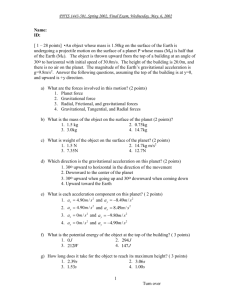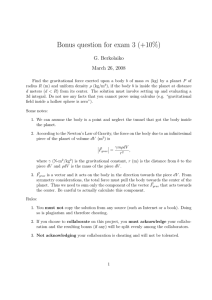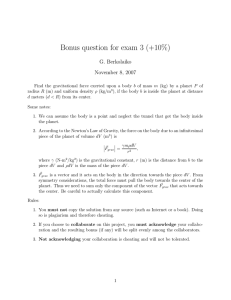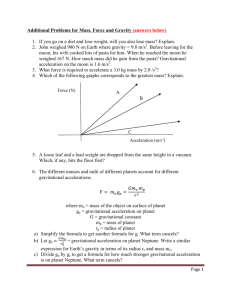Monday, May 6, 2002
advertisement
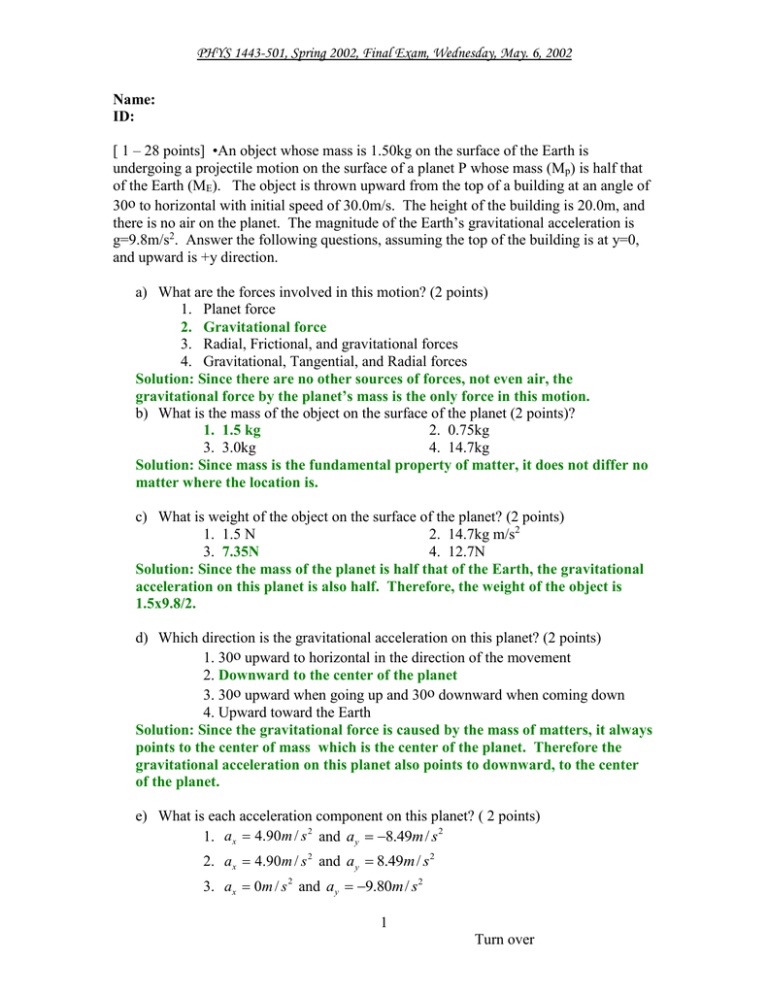
PHYS 1443-501, Spring 2002, Final Exam, Wednesday, May. 6, 2002 Name: ID: [ 1 – 28 points] •An object whose mass is 1.50kg on the surface of the Earth is undergoing a projectile motion on the surface of a planet P whose mass (Mp) is half that of the Earth (ME). The object is thrown upward from the top of a building at an angle of 30o to horizontal with initial speed of 30.0m/s. The height of the building is 20.0m, and there is no air on the planet. The magnitude of the Earth’s gravitational acceleration is g=9.8m/s2. Answer the following questions, assuming the top of the building is at y=0, and upward is +y direction. a) What are the forces involved in this motion? (2 points) 1. Planet force 2. Gravitational force 3. Radial, Frictional, and gravitational forces 4. Gravitational, Tangential, and Radial forces Solution: Since there are no other sources of forces, not even air, the gravitational force by the planet’s mass is the only force in this motion. b) What is the mass of the object on the surface of the planet (2 points)? 1. 1.5 kg 2. 0.75kg 3. 3.0kg 4. 14.7kg Solution: Since mass is the fundamental property of matter, it does not differ no matter where the location is. c) What is weight of the object on the surface of the planet? (2 points) 1. 1.5 N 2. 14.7kg m/s2 3. 7.35N 4. 12.7N Solution: Since the mass of the planet is half that of the Earth, the gravitational acceleration on this planet is also half. Therefore, the weight of the object is 1.5x9.8/2. d) Which direction is the gravitational acceleration on this planet? (2 points) 1. 30o upward to horizontal in the direction of the movement 2. Downward to the center of the planet 3. 30o upward when going up and 30o downward when coming down 4. Upward toward the Earth Solution: Since the gravitational force is caused by the mass of matters, it always points to the center of mass which is the center of the planet. Therefore the gravitational acceleration on this planet also points to downward, to the center of the planet. e) What is each acceleration component on this planet? ( 2 points) 1. ax 4.90m / s 2 and ay 8.49m / s 2 2. ax 4.90m / s 2 and a y 8.49m / s 2 3. ax 0m / s 2 and ay 9.80m / s 2 1 Turn over PHYS 1443-501, Spring 2002, Final Exam, Wednesday, May. 6, 2002 4. ax 0m / s 2 and ay 4.90m / s 2 Solution: Since the mass of the planet is half that of the Earth, the gravitational acceleration on this planet is also half, and the gravitational acceleration points downward, the correct acceleration components are ax=0 and ay=-4.9m/s2. f) What is the potential energy of the object at the top of the building? ( 3 points) 1. 0 J 2. 294 J 3. 212W 4. 147J Solution: Since the mass of the planet is half that of the Earth, the gravitational acceleration on this planet is also half, and the object is at the top of the building whose height is 20m. Therefore the potential energy of the object at the top of the building is U=mg’h=mgh/2=1.5x9.8x20/2=147J. g) How long does it take for the object to reach its maximum height? ( 3 points) 1. 2.39s 2. 3.06s 3. 1.53s 4. 1.00s Solution: Since the gravitational acceleration g’=1/2g, this must be taken into account in computing the time. Since at the maximum height vy=0, we obtain h) How long would it take for the object to hit the surface of the planet? (3 points) 1. 9.8s 2. 7.26s 3. 14.3s 4. 6.12s i) How far is the object away from the initial position when it hits the surface of the planet? ( 3 points) 1. 372m 2. 94m 3. 188m 4. 159m j) What is the coordinate of the maximum height the object would reach? ( 3 points) 1. 11.5m 2. 31.5m 3. 43.0m 4. 23.0m k) What is the kinetic energy of the object just before it hits the surface of the planet? ( 3 points) 1. 822 J 2. 969 J 3. 1240J 4. 294 J 2 Turn over PHYS 1443-501, Spring 2002, Final Exam, Wednesday, May. 6, 2002 [2– 25 points]Answer the following questions in a system consists of four small spheres as shown in the figure, assuming the radii are negligible and the rods connecting the spheres are massless. a) Determine the coordinate of the Center of Mass of the system. (5points) Solution m x m m y m xCM i i 2M (l / 2) Ml 0 2m 0 m 0 0 2M M 2m m 3M m 2M 0 0 M m b 2m (b / 2) 0 0 2 M M 2m m 3M m i yCM i i i Therefore the coordinate of the center of mass of this system is CM ( xCm , yCM ) 0,0 b) Compute the moment of inertia and the rotational kinetic energy when the system rotates clockwise about the x-axis at the angular speed . (5 points each) Solution 2 3 1 I mi ri mb 2m b mb2 2 2 Therefore the rotational kinetic energy of the system for this rotation is 1 13 3 K I 2 mb2 2 mb2 2 2 2 2 4 2 2 3 Turn over PHYS 1443-501, Spring 2002, Final Exam, Wednesday, May. 6, 2002 4 Turn over PHYS 1443-501, Spring 2002, Final Exam, Wednesday, May. 6, 2002 c) Compute the moment of inertia, using parallel axis theorem, and the rotational kinetic energy when the system is rotating clockwise about the z axis at the angular speed points each) Solution 2 I Md I Cm 2 2 3 1 1 M 0 mi ri Ml 2M l mb2 2m b mb2 Ml 2 2 2 2 2 2 2 Therefore the rotational kinetic energy of this motion is 1 13 3 K I 2 mb2 Ml 2 2 mb2 Ml 2 2 2 2 2 4 5 Turn over PHYS 1443-501, Spring 2002, Final Exam, Wednesday, May. 6, 2002 [ 3– 25 points] The motion of a random point on a sinusoidal wave is expressed as: 2 y 1.50cos x 16.0t m 0.500 The mass of the string is 500g, and its length is 2.5m. a) What kind of wave does this equation of motion represent (2 points)? 1. Standing wave 2. Free Fall 3. Harmonic Oscillation 4. Traveling wave b) What is the wavelength of this wave (2 points)? 1. 1.5m 2. 2m 3.0.50m 4. 16m/s c) What is the frequency of this motion (2 points)? 1. 2s 2. 8.00/s 3. 16/s 4. 16s d) What is the maximum amplitude of this motion (2 points)? 1. 1.50cm 2. 3.00m 3. 1.50m 4. 16m e) What is the transverse speed of the point (2 points)? 2 x 16.0t m / s 1. v y 24.0 sin 0.500 2 x 16.0t m / s 2. v y 6 sin 0.500 2 x 16.0t / s 3. v y 1.5sin 0.500 2 x 16.0t m / s 4. v y 24.0 cos 0.500 f) What is the transverse acceleration of the point (2 points)? 2 x 16.0t m / s 1. a y 24.0 cos 0.500 2 x 16.0t m / s 2 2. a y 384 2 cos 0.500 2 x 16.0t m / s 2 3. a y 36.0 cos 0.500 2 x 16.0t m / s 4. a y 24.0 sin 0.500 g) What is the angular wave number (2 points)? 1. k 16m 2. k 16 / m 2 2 /m m 3. k 4. k 0.500 0.500 h) What is speed of the wave (3 points)? 1. v 4.00m / s 2. v 16m / s 2 s/m 3. v 4. v 8.00m / s 0.500 6 Turn over PHYS 1443-501, Spring 2002, Final Exam, Wednesday, May. 6, 2002 i) What is the line density of the string (2 points)? 1. 0.500kg/m 2. 1.00kg/m 3. 0.200kg/m 4.3.00kg j) What is the power supplied by the tension on the string to keep this motion (3 points)? 1. P 512W 2. P 2490W 3. P 2274W 4. P 2747 J k) What is the total energy put into the system to sustain this wave for 10 seconds (3 points)? 1. E 2.49 10 4 J 2. E 2.27 104 J 3. E 5.12 103 J 4. E 2.75 10 4 J 7 Turn over PHYS 1443-501, Spring 2002, Final Exam, Wednesday, May. 6, 2002 [4– 22 points]After a storm the water level at the Hoover dam on planet K, whose mass is twice that of the Earth, is reaching to a height of 50m. The gravitational acceleration on the surface of the Earth is 9.8m/s2. The density of water is 1.00 103 kg / m3 . Width of the dam is 250m. Answer the following questions. a) Determine the pressure exerted on the dam at 20m from the surface of the water, ignoring the air pressure. (5points) Solution Since the dam is on the surface of a planet whose mass is twice of that of the Earth, the gravitational acceleration on the surface of this planet is different than the one on the Earth and is twice the gravitational acceleration on the Earth’s surface. Thus, the planet’s gravitational acceleration g’ =2g. P g 'h 2 gh 2 1.00 103 9.80 20.0 3.92 105 N / m2 b) Determine the total force exerted on the dam by the water. (7 points) Solution Since the force varies as a function of the depth, one needs to integrate the forces on the infinitesimal area of the dam’s wall. The small force on the area defined by the width w and the height dy is dF=PdA=Pwdy. Thus by integrating dF through the entire height one can obtain the total force F dF PdA g 'hwdy 2 g H y wdy H H 0 0 H H 0 0 H 1 2 2 g Hy y 2 w gH 2 w 2 1.00 103 9.80 50 250 6.10 109 N 2 0 8 Turn over PHYS 1443-501, Spring 2002, Final Exam, Wednesday, May. 6, 2002 c) Assuming the width of the dam is constant throughout the entire height of the dam, design a dam that can hold the water and explain why you designed the dam the way you did. (10 points) Solution Since the pressure exerted on the dam by the water increases as a function of depth, the total force applied on the dam also increases. The total force exerted on the wall of the dam is proportional to square of the height H of the dam. Therefore the dam must be designed to balance this variation of the force as a function of the depth. Therefore the shape of the wall of the dam will follow a parabola as answer given in the previous problem F gH 2 w . So the design of the dam would look like 9 Turn over PHYS 1443-501, Spring 2002, Final Exam, Wednesday, May. 6, 2002 10 Turn over PHYS 1443-501, Spring 2002, Final Exam, Wednesday, May. 6, 2002 Useful Formulae Velocity: v f vi at 1 Position: r f ri vit at 2 2 Center of Mass: r CM m r m i i i Linear Momentum: p mv 1 Kinetic Energy: K mv2 2 Moment of Inertia: I r 2 dm Torque: Fd I where d is moment arm and is the angular acceleration 1 Rotational Kinetic Energy: K R I 2 2 Angular Momentum: L r p L I Gravitational force between two objects with masses M1 and M2 at the distance r is GM1M 2 F r2 Pressure exerted by a liquid of density in the depth h is P gh 1 Energy transfer by a sinusoidal wave on a string is P 2 A2v where is the density 2 of the string, is the angular frequency, A is the amplitude, and v is the speed of wave. The solutions for a 2-dimensional equation: ax 2 bx c 0 are: x b b2 4ac 2a 11 Turn over
